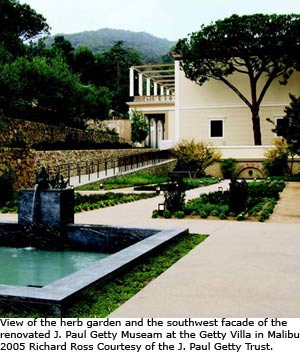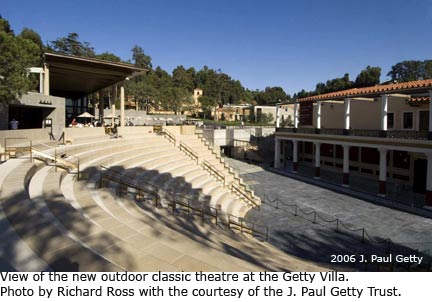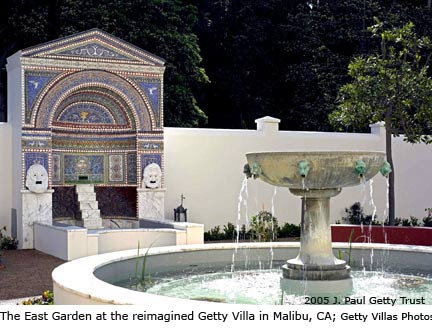The Getty Trust makes it look so easy: Acquire priceless pieces. Display in fabulous site. Charge no admission fee. Sit back. Let the clamoring crowds and wild acclaim follow.
Maybe it’s not quite so simple, and perhaps the late oil magnate’s billions play a part, but with the reopening of the Getty Villa in Malibu, J. Paul Getty’s namesake foundation has pulled off the hat trick. For the third time, it has successfully launched a shrine to art and the art experience in Los Angeles, and by doing so, it has firmly secured Southern California’s–and the Getty Trust’s–reputation for sophisticated art appreciation.
It’s impossible to miss the Getty Center, the massive campus perched atop the Santa Monica Mountains in Brentwood, but unbeknownst to many people, it wasn’t the first Getty venture in town. It all started in Malibu in 1974, at the Villa dei Papiri replica J. Paul Getty built to house his art collection. With meticulously manicured gardens and breathtaking ocean views to complement the ancient masterpieces, the Getty Villa reinvented the visitor experience. But in 1997, when the Getty Center opened up, the original villa closed for renovations. Nine years and $275 million later, the Getty Villa is back and better than ever.
Like the Getty Center, the Getty Villa’s visual impact is immediately apparent, though the villa is as classical as the museum is modern. Modeled after a first-century Roman country house buried under the ash of Mt. Vesuvius, the villa transports you into the ancient world upon entrance. Visitors first approach the villa from below, then make their way up and above it. Looking down, they’ll see the villa enclosed in what looks like an excavation site–a clever context for what awaits.
Once inside, you can make your way through the 23 thematic galleries that, at any given time, house 1,200 Greek, Roman, and Etruscan antiquities from Getty’s 44,000-piece collection. At the time of this writing, the villa’s main exhibit, Colors of Clay, features more than 100 Athenian vases made between 550 and 340 B.C.
Beginning early September, the villa will present a new stage adaptation of Euripides’s Hippolytos, the inaugural production in the Barbara and Lawrence Fleischman Theater, an outdoor amphitheater based on ancient examples. The accompanying exhibition, Enduring Myth: The Tragedy of Hippolytos and Phaidra, will highlight approximately 40 objects from all forms of media that illuminate the centuries-old spell cast by this tragic love story.

Once again, tickets are free to the public, but in this early stage, visitors must call ahead or check the Getty website for them. At $7, the parking is plentiful. Families with children are welcome; children can play and adorn vases in the Family Forum, or they can take in the Timescape Room’s interactive presentation of the Getty’s art properties in historical context.
The Getty Villa has returned to expand on what it started. Residents of and visitors to Los Angeles now have another world-class art address to frequent. For a peek into the good life–and a generous helping of high culture–the Getty Villa and the Getty Museum fulfill both demands and will invite repeated viewings.









